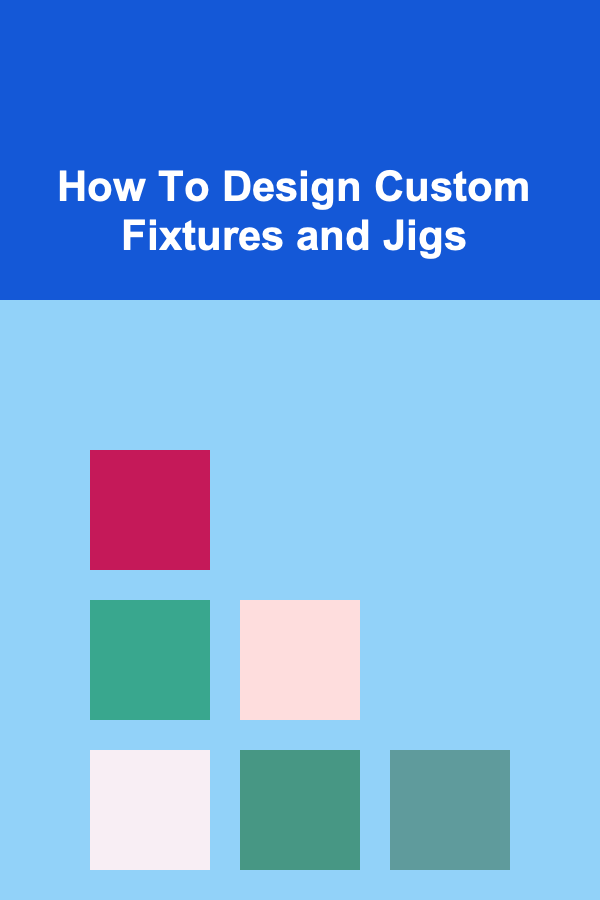
How To Design Custom Fixtures and Jigs
ebook include PDF & Audio bundle (Micro Guide)
$12.99$8.99
Limited Time Offer! Order within the next:

Designing custom fixtures and jigs is a fundamental skill in manufacturing, machining, and assembly processes. These tools are used to hold, support, or align parts during the production of components, ensuring accuracy, consistency, and efficiency. Custom-designed fixtures and jigs are especially important when standard tools do not meet the specific needs of a particular task. This article explores the principles and methods involved in designing these tools, from understanding their purpose to selecting materials and ensuring their effectiveness.
What Are Fixtures and Jigs?
Fixtures
A fixture is a device used to hold a workpiece in a specific location, orientation, or alignment while it is being worked on, often during machining, welding, or assembly. Fixtures help ensure that parts remain stationary and accurately positioned relative to cutting tools, sensors, or other machines during the manufacturing process. By stabilizing the workpiece, fixtures help maintain consistency in part dimensions and improve productivity by reducing the time needed to reposition parts.
Jigs
A jig, on the other hand, is a tool that not only holds the workpiece but also guides the cutting or drilling tool during the operation. Jigs are used to ensure precision when drilling holes, shaping surfaces, or performing other tasks that require a high degree of accuracy. While fixtures provide stability and support, jigs provide both stability and guidance for tools, helping operators produce consistent parts with precise dimensions.
Why Do You Need Custom Fixtures and Jigs?
Custom fixtures and jigs are necessary when standard off-the-shelf options do not meet the unique requirements of a specific task. Here are some reasons why custom tools are important:
- Unique Workpiece Geometry: Standard fixtures and jigs may not accommodate the specific shapes or sizes of the parts being worked on, necessitating the creation of custom tools.
- Precision: When high accuracy is required in machining or assembly, custom fixtures and jigs are often the only way to achieve the desired level of precision.
- Cost and Time Efficiency: Although designing a custom fixture or jig requires an upfront investment, they can save time and reduce errors in the long run. By optimizing the process, custom tools can increase throughput and reduce the likelihood of rework.
- Safety: Properly designed fixtures and jigs ensure that parts are securely held, reducing the risk of accidents during machining or assembly processes.
- Improved Production Flow: Custom tools can streamline the production process by ensuring parts are handled more efficiently, reducing the need for manual repositioning or complex setups.
Steps in Designing Custom Fixtures and Jigs
The process of designing custom fixtures and jigs involves several critical steps that ensure the final tool meets the specific needs of the operation. Let's explore each step in detail.
Step 1: Understand the Workpiece and Process Requirements
Before designing a fixture or jig, it's crucial to have a thorough understanding of the workpiece and the process it will undergo. This includes:
- Part Geometry: Consider the shape, size, and features of the part to ensure the fixture or jig accommodates it correctly.
- Manufacturing Process: Determine the specific operation (e.g., machining, welding, assembly, or drilling) to ensure the design supports the requirements of that process.
- Tolerance and Precision: Understand the level of accuracy required for the final part. This will influence the design of the fixture or jig, especially when it comes to aligning and holding the workpiece.
- Materials: Know the material of the workpiece and any potential material changes during processing (such as heating during welding) that may affect the design.
Step 2: Define the Functional Requirements
Once you have a clear understanding of the workpiece and process, define the functional requirements of the fixture or jig. These include:
- Holding Mechanism: Determine how the workpiece will be held in place during the operation. This could include clamping, magnetic, or vacuum-based holding systems.
- Accessibility: The tool should allow for easy access to the workpiece, particularly in areas that need to be cut, drilled, or welded.
- Tool Guiding: For jigs, determine how the guiding system will work to direct the tool along the correct path.
- Adjustability: Consider whether the fixture or jig needs to be adjustable to accommodate parts of different sizes or shapes.
- Ergonomics: Ensure the fixture or jig is easy for operators to use, minimizing effort and reducing fatigue during long production runs.
- Safety: Incorporate features that minimize the risk of injury, such as guardrails or clamps that prevent workpieces from shifting unexpectedly.
Step 3: Design for Ease of Use and Setup
Fixtures and jigs should be designed with the end user in mind. Consider how easy it will be to set up and use the tool:
- Quick Setup: The fixture or jig should be easy to load and unload, with minimal adjustments required during the setup process. This helps reduce downtime and improve efficiency.
- Clear Markings: Include markings or guides on the fixture or jig to help operators position the workpiece accurately and reduce setup errors.
- Modularity: For large or complex operations, consider modular designs that allow for easy reconfiguration of the fixture or jig to accommodate different tasks or workpieces.
Step 4: Select Materials
Choosing the right materials for fixtures and jigs is essential to ensure durability, stability, and performance. Materials should be chosen based on the specific requirements of the manufacturing process and the workpiece material. Common materials include:
- Steel: Strong and durable, making it suitable for heavy-duty fixtures and jigs that need to withstand significant force or pressure.
- Aluminum: Lighter than steel, aluminum is often used when weight is a concern, but still provides good strength and rigidity.
- Cast Iron: Known for its vibration-damping properties, cast iron is used for fixtures and jigs that need to resist deformation under heavy loads or high-speed operations.
- Plastic and Composites: Used for lighter fixtures or jigs where the workpiece material does not generate high forces. Composites offer strength without the weight of metals and can be useful in non-metallic applications.
The choice of material also affects the overall cost of the fixture or jig, so balance the material's properties with the project's budget.
Step 5: Ensure Proper Alignment and Stability
Precision is paramount when designing fixtures and jigs. Ensuring the proper alignment of the workpiece and stability of the tool is essential for achieving the desired accuracy. This includes:
- Accuracy of the Hold: The fixture or jig must hold the workpiece in the correct orientation and position relative to the cutting tools, assembly components, or welders.
- Minimizing Movement: Ensure that the workpiece does not move during the operation. This can be accomplished through clamping, friction, or support structures.
- Tool Alignment: For jigs, make sure that the guide rails or pins align the cutting or drilling tool in the correct direction, ensuring precision in each cut or operation.
Step 6: Prototype and Test
Before finalizing the design, it's crucial to build a prototype and test it in real-world conditions. Prototyping allows you to identify any potential issues, such as poor ergonomics, difficult setup, or instability, before the final design is produced.
During testing, evaluate the fixture or jig based on:
- Ease of Setup: How quickly can operators set up the tool? Are there any issues with part loading or adjustments?
- Functionality: Does the fixture or jig hold the workpiece securely? Does the jig guide the tool accurately?
- Durability: Will the fixture or jig withstand the stresses and wear of repeated use over time?
Make adjustments based on the testing phase to ensure the final product meets the desired performance standards.
Step 7: Finalize the Design and Production
Once the prototype has been tested and refined, finalize the design and prepare for production. This step involves:
- Creating Technical Drawings: Detailed drawings are essential for manufacturing the fixture or jig. These drawings should include dimensions, tolerances, material specifications, and assembly instructions.
- Manufacturing: Work with a manufacturer or machinist to produce the fixture or jig according to the finalized design. This may involve precision machining, welding, or assembling various components.
- Quality Control: After the fixture or jig is manufactured, conduct a final round of testing to ensure it meets all specifications and functional requirements.
Best Practices for Designing Custom Fixtures and Jigs
- Collaborate with Operators: Work closely with the people who will be using the fixtures or jigs. They can provide valuable insights into the usability and functionality of the tool.
- Consider Maintenance: Design fixtures and jigs with ease of maintenance in mind. Over time, these tools may need adjustments or replacements, so ensuring that they are easy to maintain can improve their longevity.
- Optimize for Production Speed: While accuracy is crucial, don't overlook the impact of the fixture or jig on the overall production speed. Custom tools should enhance throughput without sacrificing quality.
- Test Iteratively: Don't wait until the final product is complete to test your design. Test at various stages of the design and production process to identify potential issues early.
Conclusion
Designing custom fixtures and jigs is an essential part of modern manufacturing, ensuring that parts are produced with accuracy, efficiency, and consistency. By understanding the specific needs of the workpiece and the process, selecting the right materials, and focusing on user-friendliness, you can create effective tools that enhance productivity and reduce errors. While designing custom fixtures and jigs requires careful planning, prototyping, and testing, the end result is a tool that contributes to better production processes and higher-quality finished products.

How to Advertise Your Home Rental Property for Maximum Exposure
Read More
How to Make Your Rental Property Pet-Friendly Without Risk
Read More
How to Seek Investment Advice from a Financial Advisor: Key Questions to Ask
Read More
How to Use Movement for Mindful Connection
Read More
How to Understand Push-Your-Luck Board Games
Read More
From Chaos to Calm: Organizing Your Family Life
Read MoreOther Products

How to Advertise Your Home Rental Property for Maximum Exposure
Read More
How to Make Your Rental Property Pet-Friendly Without Risk
Read More
How to Seek Investment Advice from a Financial Advisor: Key Questions to Ask
Read More
How to Use Movement for Mindful Connection
Read More
How to Understand Push-Your-Luck Board Games
Read More